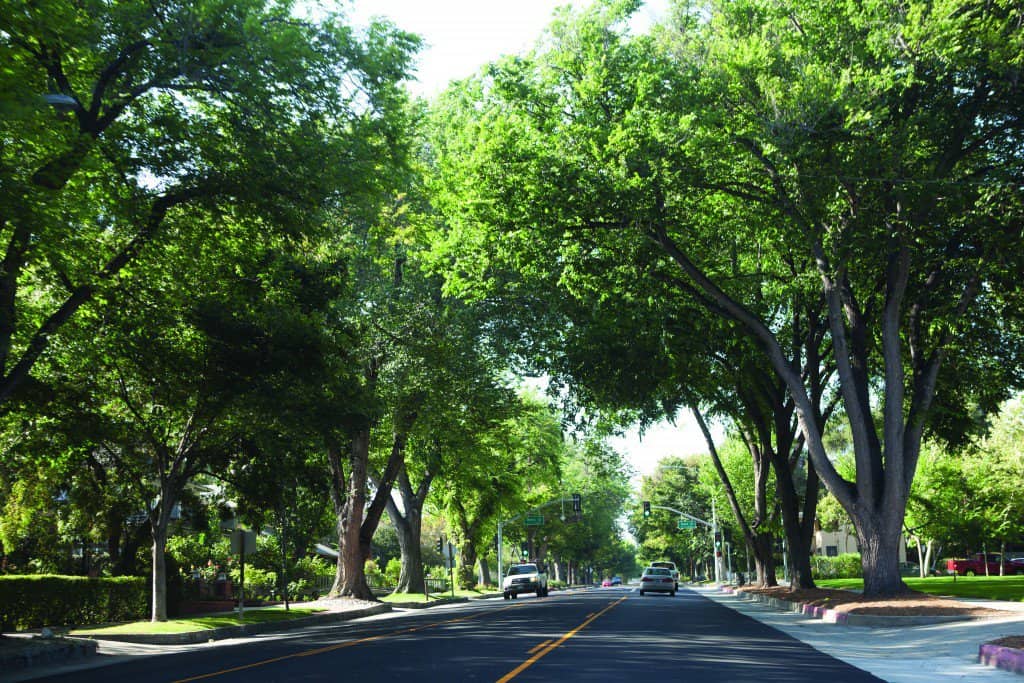Saving the trees in the city of…

by John Neiuber
It has been a tough several years for the trees that have given us the designation of the City of Trees. In 2014 and 2015 the drought saw many street and private trees threatened and suffer. The city began turf reduction programs and homeowners either eliminated or reduced the coverage of lawns in favor of more drought tolerant and native plants. What resulted was a reduction in water usage, but there were unintended results. Many street trees suffered as turf was removed in parkways and medians and the subsequent lack of ground cover that holds water in, coupled with either a lack of or inadequate tree irrigation, resulted in trees being stressed or dying.
After the drought of 2012 to 2016, we then experienced a few years of better rainfall, and now a severe drought has returned. In January, the windstorm we experienced felled many trees, delivering another blow to our urban forest. The loss of trees was exasperated by an aging tree population. Many of the original trees planted over 100 years ago are nearing end-of-life or have been decimated by disease. Some have not received adequate water, thereby leading to inadequate root systems. However, our urban forest can survive increased heat and insects remarkably well, unless they are thirsty.
Seven years ago, in June 2015, this newspaper published my column titled Welcome to Deadwood — Claremont’s Tree Emergency. With over 25,000 trees throughout the town, it is time now to build awareness and plan to make sure trees receive adequate water to grow and thrive in the current drought. In 2015, the City of Claremont leadership along with many civic groups such as Sustainable Claremont, the Claremont Garden Club, California Botanic Garden and Claremont Heritage, among others, joined forces to build awareness through education, social media postings and placement of yard signs. The results were good; however, it is time to ensure the actions that were implemented then become routine now. After all, we have spent about 15 of the past 20 years in a drought in California.
Just as tile roofs are a character defining feature of Spanish Revival houses or a gambrel roof of a Colonial Revival, trees are a character defining feature of Claremont — probably the character defining feature of the town. The history of trees in the city is the history of the city. The very first action of the first town meeting in 1889, was for a three-member tree committee to secure 250 trees to be planted on each street. That was the beginning of tree planting in Claremont. That first action is what led to the spectacular urban forest we enjoy today.
Our urban forest is under stress. Many homeowners will respond to the water restrictions in a positive manner but will have a dilemma about watering trees. It is not a matter of saving water or saving trees. It is not an either/or dilemma. We can save water and save our trees. Under the new guidelines, hand watering of trees is allowed any day of the week before 9 a.m. or after 5 p.m. And drip irrigation systems are allowed any day of the week with the same time of day restrictions as hand watering.
Most mature trees need water once or twice a month. Water needs to soak down at least 18”. Use a soaker hose spiraled under the drip line of your tree (the soil beneath the edge of the leaves). Install a drip system or use an oscillating sprinkler on a low setting to slowly soak as much of the root system as possible. To ensure the tree is getting enough water, measure using a “soil probe” available at home improvement stores.
Young trees need on average 15 gallons of water about once a week. Create a three-to-four foot-wide basin around the tree to hold the water. Use a bucket or tree bag to deliver water slowly into the basin. You can conserve water and keep your young tree healthy. Collect water in a bucket while you shower or other faucets warm up. Drill a 1/8” hold near the bottom of a second bucket and place it near the trunk of your young tree. Fill the second bucket with the shower water you saved. The water will slowly drip into the soil. The young tree only requires about the same amount of water used in a six-minute shower. Reduce your shower by one minute a day and your tree will still thrive.
The city is responsible for planting and pruning the trees in our parkways, but homeowners are responsible for watering them. This arrangement dates to the beginning of the planting of trees in the city. Go ahead and remove those sprinklers and install low water landscaping, but don’t forget to include a drip system for the parkway trees.
The benefits of trees are immeasurable. They offer a tremendous pedestrian experience; they combat climate change by absorbing carbon dioxide, they produce oxygen, they cool our homes and streets by as much as 10 degrees, they can help prevent heat-related deaths, they reduce stress, they reduce power consumption, they define the character and charm of a neighborhood and its homes; and they provide shade in our public places. Trees also have economic benefits. In a 2014 Claremont Municipal Forest Assessment, the street trees alone provided over $3 million annually in benefits with over $2.8 million attributed to increased property values and aesthetic enjoyment.
Preservation is not just about the built environment. It is also about protecting our urban landscapes and our natural resources. It is about preserving our urban forest. All these things are the stuff of which a city is made, the stuff that informs and shapes us, and the stuff that defines for us our relationship to our environment and to what we elevate as important in our community. With the new water restrictions in place, we must do better this time round to ensure that trees remain the object in the city of.








0 Comments